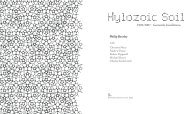The Inner Studio - Riverside Architectural Press
The Inner Studio - Riverside Architectural Press
The Inner Studio - Riverside Architectural Press
Create successful ePaper yourself
Turn your PDF publications into a flip-book with our unique Google optimized e-Paper software.
THE INNER STUDIO<br />
grand projects were not the usual galleries or public spaces, but the<br />
occasional outburst of infrastructure. In Toronto beauty needed a<br />
purpose and we were mostly comfortable with projects that were<br />
practical like the R.C. Harris sewage treatment plant or the Bloor<br />
Street Viaduct. <strong>The</strong>se were the great palaces in the city the way<br />
barns are great temples in the rural landscape. We remained a small<br />
town, a good place, and our charm was the self-effacing modesty of<br />
our imagination.<br />
Growth<br />
<strong>The</strong>n one day in 1963 everything changed. A bomb blew up a<br />
mailbox in Montreal’s ruling English-speaking neighborhood of<br />
Westmount. A group that wanted Quebec to leave Canada claimed<br />
responsibility. People in Montreal were frightened and an exodus<br />
began; soon banks, small businesses, and insurance companies<br />
with thousands of their employees were headed west up Highway<br />
401 toward Toronto.<br />
We really weren’t expecting all these Montrealers and they<br />
weren’t expecting us. <strong>The</strong>y were leaving a handsome, corrupt, and<br />
fun-loving cosmopolitan city with a hockey team that was unstoppable.<br />
In Toronto, drinking and dancing had been so regulated that<br />
they were nearly illegal. <strong>The</strong> city was serious about littering and<br />
illegally crossing the street. A subway system had just been built<br />
that exuded humility and restraint. <strong>The</strong> more exotic stations were<br />
named “Queen” and “King.” To make matters more complex, in the<br />
wake of Montreal’s trauma, the wave of immigration that had<br />
started after World War II began to grow. First came the Italians,<br />
half a million of them from southern Italy, skilled in construction<br />
trades. <strong>The</strong>n successive waves of Portuguese, Hungarians, West<br />
Indians, Chinese via Hong Kong, then East Asians, Koreans, and<br />
Greeks. Just when this surge seemed to subside, new waves of<br />
immigrants and refugees began to arrive from South America,<br />
Central America, Vietnam, Africa, and the Middle East. As is<br />
usually the case, fathers, brothers, and sons arrived and, once they<br />
had saved enough, their wives, parents, and children, brothers<br />
and sisters, aunts and uncles followed. <strong>The</strong>y moved into the old<br />
180





